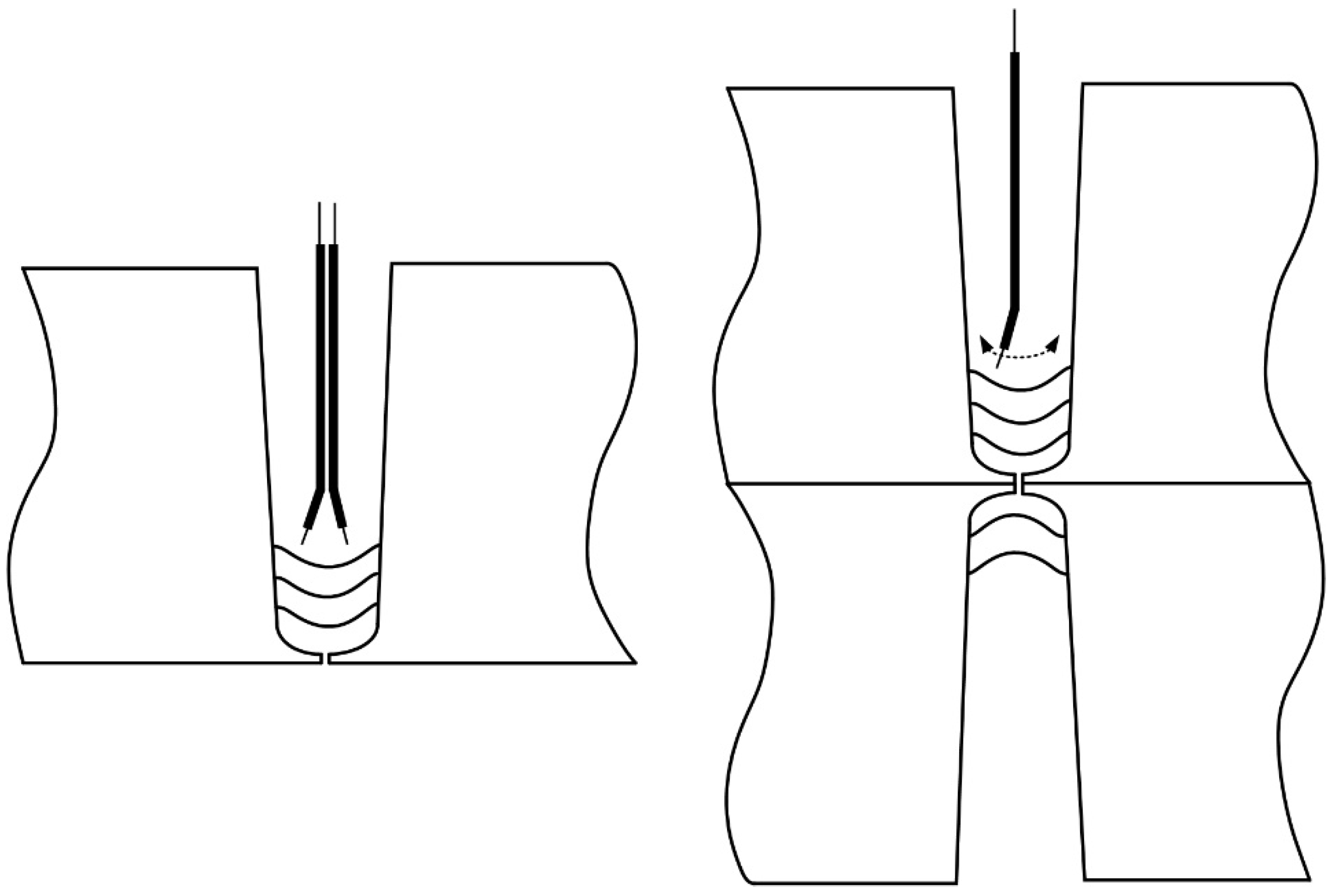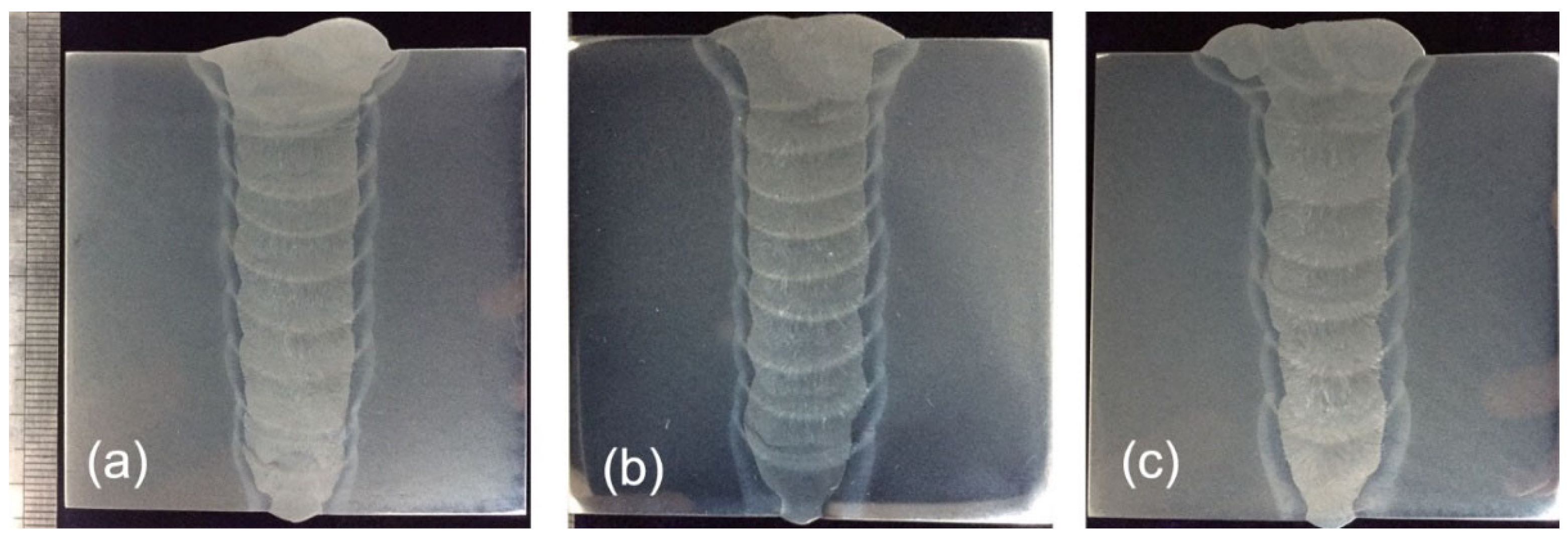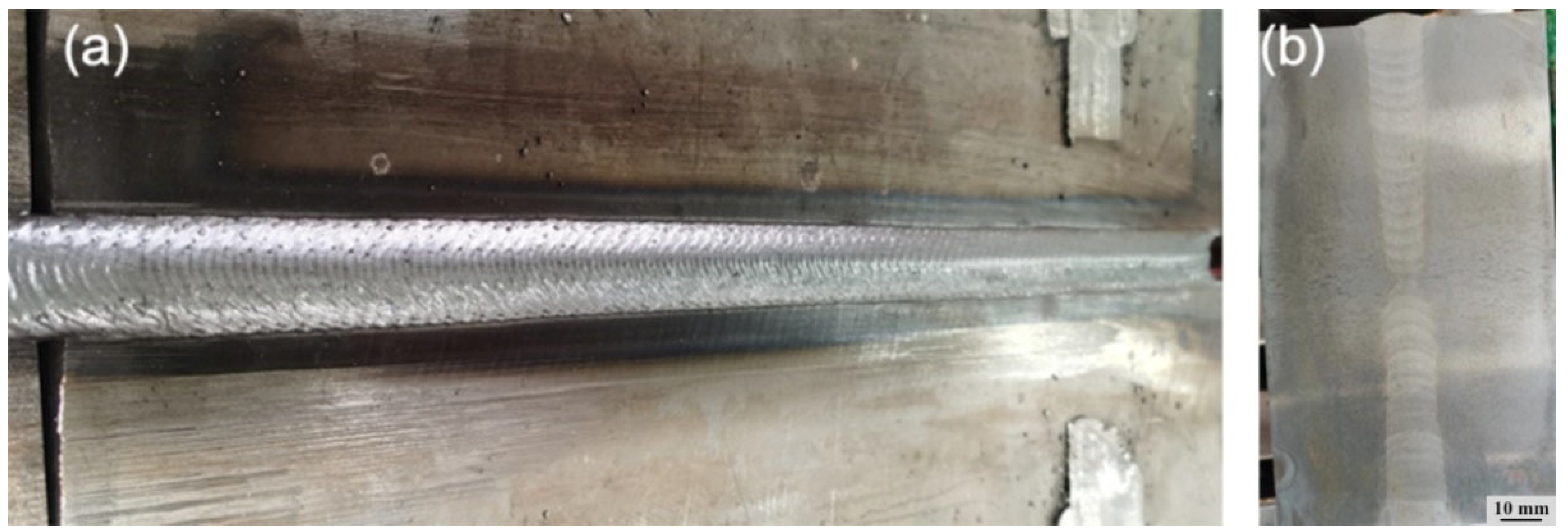Microstructure and Mechanical Properties of the Ternary Gas Shielded Narrow-Gap GMA Welded Joint of High-Strength Steel
Abstract
:1. Introduction
2. Experimental Materials, and Methods
3. Results and Discussion
3.1. Effects of Heat Input on the Microstructure and Mechanical Properties
3.2. Microstructure and Mechanical Properties of the Welded Joint of Extra-Thick Q690E Steel Plate
4. Conclusions
- The completed narrow-gap welded joint of Q690E high-strength steel with sufficient sidewall penetration can be obtained using 80%Ar-10%CO2-10%He ternary shielding gas. Preheating before welding was not used.
- The welding heat input affects the microstructure and mechanical properties of the welded joint. As the heat input increases, the morphology of bainitic ferrite changes from AF to LB, which leads to the decrease in the tensile strength and low-temperature impact toughness of the welded joint. The grain size of the heat-affected zone increases with the increase in the heat input.
- The tensile strength of the tandem wire narrow-gap GMA welding joints could be improved by optimizing the heat input through changing the welding speed. The average tensile strength was 795.3 MPa with a welding speed of 350 mm/min.
- Swing-arc narrow-gap welding provides a lower heat input and the microstructure of the welded joint was further improved. Mechanical properties of swing-arc narrow-gap GMA welding joints were better than those of tandem wire narrow-gap GMA welding joints. A 155 mm-thick plate was welded using a double-sided groove. Complete welded joints were obtained and the average tensile strength of the welded joint exceeded 835.4 MPa, and the low-temperature impact toughness at −40 °C exceeded 69 J, which meets the service requirements.
Author Contributions
Funding
Institutional Review Board Statement
Informed Consent Statement
Data Availability Statement
Conflicts of Interest
References
- Schneider, C.; Ernst, W.; Schnitzer, R.; Staufer, H.; Vallant, R.; Enzinger, N. Welding of S960MC with undermatching filler material. Weld. World 2018, 62, 801–809. [Google Scholar] [CrossRef] [Green Version]
- Nishioka, K.; Ichikawa, K. Progress in thermomechanical control of steel plates and their commercialization. Sci. Technol. Adv. Mater. 2012, 13, 023001. [Google Scholar] [CrossRef] [PubMed]
- Rauch, R.; Kapl, S.; Posch, G.; Radlmayr, K. High strength low alloy steel weldments with accommodated qualities to the base metal. BHM Berg-Und Hüttenmännische Mon. 2012, 157, 102–107. [Google Scholar] [CrossRef]
- Tavares, S.M.; De Castro, P.M. Damage Tolerance of Metallic Aircraft Structures: Materials and Numerical Modelling; Springer: Cham, Switzerland, 2019. [Google Scholar]
- Veritas, D.N. Offshore Standard DNV-OS-B101 Metallic Materials; DNV-GL: Høvik, Norway, 2009. [Google Scholar]
- Miki, C.; Homma, K.; Tominaga, T. High strength and high performance steels and their use in bridge structures. J. Constr. Steel Res. 2002, 58, 3–20. [Google Scholar] [CrossRef]
- Esterl, R.; Sonnleitner, M.; Gschöpf, B.; Schnitzer, R. Influence of V and Nb Micro-Alloying on Direct Quenched and Tempered Ultra-High Strength Steels. Steel Res. Int. 2019, 90, 1800640. [Google Scholar] [CrossRef] [Green Version]
- Schaupp, T.; Schroepfer, D.; Kromm, A.; Kannengiesser, T. Welding residual stresses in 960 MPa grade QT and TMCP high-strength steels. J. Manuf. Process. 2017, 27, 226–232. [Google Scholar] [CrossRef]
- Yi, H.-J.; Lee, Y.-J.; Kim, J.-Y.; Kang, S.-S. Effect of microstructure and chemical composition on cold crack susceptibility of high-strength weld metal. J. Mech. Sci. Technol. 2011, 25, 2185–2193. [Google Scholar] [CrossRef]
- Węgrzyn, T.; Szymczak, T.; Szczucka-Lasota, B.; Łazarz, B. MAG welding process with micro-jet cooling as the effective method for manufacturing joints for S700MC Steel. Metals 2021, 11, 276. [Google Scholar] [CrossRef]
- Kah, P.; Pirinen, M.; Suoranta, R.; Martikainen, J. Welding of ultra high strength steels. In Advanced Materials Research; Trans Tech Publications Ltd.: Zürich, Switzerland, 2014; Volume 849, pp. 357–365. [Google Scholar]
- Cai, X.; Lin, S.; Fan, C.; Yang, C.; Zhang, W.; Wang, Y. Molten pool behavior and weld forming mechanism of tandem narrow gap vertical GMAW. Sci. Technol. Weld. Join. 2016, 21, 124–130. [Google Scholar] [CrossRef]
- Cai, X.; Fan, C.; Lin, S.; Yang, C.; Bai, J. Molten pool behaviors and forming characteristics of all-position tandem narrow gap GMAW. Int. J. Adv. Technol. 2016, 87, 2437–2444. [Google Scholar] [CrossRef]
- Christensen, K.; Sorensen, T.; Kristensen, J. Gas metal arc welding of butt joint with varying gap width based on neural networks. Sci. Technol. Weld. Join. 2005, 10, 32–43. [Google Scholar] [CrossRef]
- Wang, J.; Ren, Y.; Yang, F.; Yang, H. Novel rotation arc system for narrow gap MAG welding. Sci. Technol. Weld. Join. 2007, 12, 505–507. [Google Scholar] [CrossRef]
- Ding, M.; Tang, X.; Lu, F.; Yao, S. Welding of quenched and tempered steels with high-spin arc narrow gap MAG system. Int. J. Adv. Technol. 2001, 55, 527–533. [Google Scholar]
- Guo, N.; Lin, S.; Zhang, L.; Yang, C. Metal transfer characteristics of rotating arc narrow gap horizontal GMAW. Sci. Technol. Weld. Join. 2009, 14, 760–764. [Google Scholar] [CrossRef]
- Guo, N.; Wang, M.; Guo, W.; Yu, J.; Feng, J. Effect of rotating arc process on molten pool control in horizontal welding. Sci. Technol. Weld. Join. 2014, 19, 385–391. [Google Scholar] [CrossRef]
- Yang, C.; Guo, N.; Lin, S.; Fan, C.; Zhang, Y. Application of rotating arc system to horizontal narrow gap welding. Sci. Technol. Weld. Join. 2009, 14, 172–177. [Google Scholar] [CrossRef]
- Guo, N.; Wang, M.; Guo, W.; Yu, J.; Feng, J. Study on forming mechanism of appearance defects in rotating arc narrow gap horizontal GMAW. Int. J. Adv. Technol. 2014, 75, 15–20. [Google Scholar] [CrossRef]
- Cui, H.; Jiang, Z.; Tang, X.; Lu, F. Research on narrow-gap GMAW with swing arc system in horizontal position. Int. J. Adv. Technol. 2014, 74, 297–305. [Google Scholar] [CrossRef]
- Xu, W.; Lin, S.; Fan, C.; Yang, C. Prediction and optimization of weld bead geometry in oscillating arc narrow gap all-position GMA welding. Int. J. Adv. Technol. 2015, 79, 183–196. [Google Scholar] [CrossRef]
- Xu, W.; Lin, S.; Fan, C.; Zhuo, X.; Yang, C. Statistical modelling of weld bead geometry in oscillating arc narrow gap all-position GMA welding. Int. J. Adv. Technol. 2014, 72, 1705–1716. [Google Scholar] [CrossRef]
- Xu, W.; Lin, S.; Fan, C.; Yang, C. Evaluation on microstructure and mechanical properties of high-strength low-alloy steel joints with oscillating arc narrow gap GMA welding. Int. J. Adv. Technol. 2014, 75, 1439–1446. [Google Scholar] [CrossRef]
- Lassaline, E.; Zajaczkowski, B. North TH Narrow groove twin wire GMAW of high-strength steel. Weld. J. 1989, 68, 53–58. [Google Scholar]
- Cai, X.; Fan, C.; Lin, S.; Ji, X.; Yang, C.; Guo, W. Effects of shielding gas composition on arc properties and wire melting characteristics in narrow-gap MAG welding. J. Mater. Process. Technol. 2017, 244, 225–230. [Google Scholar] [CrossRef]
- Wang, X.; Zhao, A.; Liu, S.; Bao, Z. The measurement of SH-CCT curve and analysis on microstructure and performance of heat-affected zone of Q690 high-strength bridge steel. Int. J. Microstruct. Mater. Prop. 2021, 15, 356–369. [Google Scholar] [CrossRef]
- Xie, H.; Du, L.-X.; Hu, J.; Sun, G.-S.; Wu, H.-Y.; Misra, R. Effect of thermo-mechanical cycling on the microstructure and toughness in the weld CGHAZ of a novel high strength low carbon steel. Mater. Sci. Eng. A 2015, 639, 482–488. [Google Scholar] [CrossRef]
- Xu, J.; Zhou, X.; Zhu, D. Effect of Arc Length on Oxygen Content and Mechanical Properties of Weld Metal during Pulsed GMAW. Crystals 2022, 12, 176. [Google Scholar] [CrossRef]
- Zhong, Y.; Xiao, F.; Zhang, J.; Shan, Y.; Wang, W.; Yang, K. In situ TEM study of the effect of M/A films at grain boundaries on crack propagation in an ultra-fine acicular ferrite pipeline steel. Acta Mater. 2006, 54, 435–443. [Google Scholar] [CrossRef]
- Gourgues, A.-F.; Flower, H.; Lindley, T. Electron backscattering diffraction study of acicular ferrite, bainite, and martensite steel microstructures. Mater. Sci. Technol. 2000, 16, 26–40. [Google Scholar] [CrossRef]
- Diaz-Fuentes, M.; Iza-Mendia, A.; Gutierrez, I. Analysis of different acicular ferrite microstructures in low-carbon steels by electron backscattered diffraction. Study of their toughness behavior. Metall. Mater. Trans. A 2003, 34, 2505–2516. [Google Scholar] [CrossRef]
- Bouyne, E.; Flower, H.; Lindley, T.; Pineau, A. Use of EBSD technique to examine microstructure and cracking in a bainitic steel. Scr. Mater. 1998, 39, 295–300. [Google Scholar] [CrossRef]
- Lee, C.; Bhadeshia, H.; Lee, H.-C. Effect of plastic deformation on the formation of acicular ferrite. Mater. Sci. Eng. A 2003, 360, 249–257. [Google Scholar] [CrossRef]
- Cai, W.-Y.; Wang, Y.-B.; Li, G.-Q. Experimental and numerical study on strength of high-strength steel double-V butt-welded joint. J. Constr. Steel Res. 2022, 196, 107397. [Google Scholar] [CrossRef]








| C | Mn | Si | Cr | Ni | Mo | V | Cu | Fe | |
|---|---|---|---|---|---|---|---|---|---|
| Base metal | 0.09 | 1.47 | 0.237 | 0.426 | 0.258 | 0.26 | 0.09 | 0.42 | Bal. |
| Wire | 0.06 | 1.6 | 0.6 | 0.3 | 1.4 | 0.25 | 0.07 | 0.07 | Bal. |
| Yield Stress (MPa) | Tensile Stress (MPa) | Elongation (%) | Impact Toughness (−40 °C, J) | |
|---|---|---|---|---|
| Base metal | 690 | 770~940 | 14 | 69 |
| Wire | 715 | 805 | 17 | 60 |
| Layer | Wire Feed Speed (m/min) | Pulse Frequency (Hz) | Pulse Period (ms) | Peak Voltage (V) | Base Current (A) | Welding Speed (mm/min) |
|---|---|---|---|---|---|---|
| Backing weld | 7 (single wire) | 110 | 4.5 | 31 | 60 | 150 |
| Filling weld | 10/10 (twin wires) | 220 | 2.2 | 34 | 60 | 250/300/350 |
| Layer | Swing Speed (°/s) | Swing Amplitude (°) | Welding Voltage (V) | Welding Current (A) | Welding Speed (mm/min) | Dwell Time (ms) |
|---|---|---|---|---|---|---|
| Backing weld | 500 | 30 | 18 | 100 | 350 | 100 |
| Filling weld | 350 | 60 | 24 | 300 | 180 | 500 |
| Welding Speed/mm min−1 | Rm/MPa | /Mpa | Fracture Location | ||
|---|---|---|---|---|---|
| U | M | B | |||
| 250 | 764 | 674 | 717 | 718.3 | Weld zone |
| 300 | 827 | 797 | 737 | 787 | Weld zone |
| 350 | 803 | 784 | 799 | 795.3 | Weld zone |
| Notch Position | Impact Toughness (J) 250 mm/min | Impact Toughness (J) 300 mm/min | Impact Toughness (J) 350 mm/min | ||||||
|---|---|---|---|---|---|---|---|---|---|
| U | M | B | U | M | B | U | M | B | |
| Weld centerline | 55 | 61 | 69 | 74 | 70 | 72 | 78 | 76 | 81 |
| Fusion line | 116 | 107 | 97 | 156 | 136 | 115 | 148 | 134 | 153 |
| HAZ (FL + 2 mm) | 228 | 224 | 225 | 251 | 240 | 246 | 266 | 260 | 277 |
| Rm/MPa | /MPa | Fracture Location | ||||
|---|---|---|---|---|---|---|
| 818 | 815 | 854 | 870 | 820 | 835.4 | Weld zone |
| Notch Position | Upper Position | Middle Position | Bottom Position | ||||||
|---|---|---|---|---|---|---|---|---|---|
| Weld centerline | 73 | 87 | 79.6 | 75 | 69 | 76 | 73 | 81 | 77 |
| Fusion line | 87 | 78 | 74 | 72 | 77 | 79 | 77 | 85 | 71 |
| HAZ (FL + 2 mm) | 175 | 154 | 174 | 135 | 131 | 138 | 172 | 168 | 178 |
Publisher’s Note: MDPI stays neutral with regard to jurisdictional claims in published maps and institutional affiliations. |
© 2022 by the authors. Licensee MDPI, Basel, Switzerland. This article is an open access article distributed under the terms and conditions of the Creative Commons Attribution (CC BY) license (https://creativecommons.org/licenses/by/4.0/).
Share and Cite
Ni, Z.; Hu, F.; Li, Y.; Lin, S.; Cai, X. Microstructure and Mechanical Properties of the Ternary Gas Shielded Narrow-Gap GMA Welded Joint of High-Strength Steel. Crystals 2022, 12, 1566. https://doi.org/10.3390/cryst12111566
Ni Z, Hu F, Li Y, Lin S, Cai X. Microstructure and Mechanical Properties of the Ternary Gas Shielded Narrow-Gap GMA Welded Joint of High-Strength Steel. Crystals. 2022; 12(11):1566. https://doi.org/10.3390/cryst12111566
Chicago/Turabian StyleNi, Zhida, Fengya Hu, Yunhe Li, Sanbao Lin, and Xiaoyu Cai. 2022. "Microstructure and Mechanical Properties of the Ternary Gas Shielded Narrow-Gap GMA Welded Joint of High-Strength Steel" Crystals 12, no. 11: 1566. https://doi.org/10.3390/cryst12111566






